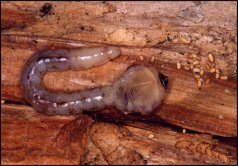
COLEOPTERA BUPRESTIDAE

The Buprestidae (Jewel Beetles or Metallic Wood Borers) are
one of the most interesting, large and well know families among
Coleoptera. Their imago (adult phase) is usually characterized by
very tough, colourful teguments. They live on trees, bushes and
herbaceous plants, especially in hot and sunny countries. Their
number decrease quicly from Tropics to high latitudes, but they
live in any Biogeographycal Region.Their
larval
phases are very different.  They are white or yellowish, with a
flattened body and head (brownish), and usually live boring wood
or bark of trunks, logs, branches and roots of many plants.
Someone can become quite noxious to agriculture and especially
arboriculture. Other larvae live in stalks of herbaceous plants (some
Acmaeoderini, many Sphenopterini, etc.), or mining
leaves (Trachys and related
genera). In a group of Buprestidae we find larvae living freely
in the soil, eating roots of any kind of plants (Julodis and related genera)
They are white or yellowish, with a
flattened body and head (brownish), and usually live boring wood
or bark of trunks, logs, branches and roots of many plants.
Someone can become quite noxious to agriculture and especially
arboriculture. Other larvae live in stalks of herbaceous plants (some
Acmaeoderini, many Sphenopterini, etc.), or mining
leaves (Trachys and related
genera). In a group of Buprestidae we find larvae living freely
in the soil, eating roots of any kind of plants (Julodis and related genera)
No other family of Beetles, except, perhaps, Chrysomelidae, is
distinguished to be so rich of colourful species. Why, during
their evolution, these Insects became so gaily-coloured? For
several species we can find specific reasons: mimicry and cryptism,
but in many other Buprestidae we must find another explanation.
The reason is very simple and obvious: unlike many other Insects,
especially among Coleoptera, using preferably other senses, they
can recognize other specimens ot their own species using their
organs of sight. When an adult is looking for food, a male is
looking for a female, or a female is trying to find a host plant
for the next generation, they probably are helped to reach the
right area by their smell, but then they must use their eyes to
identify the right target. This is probably the most important
reason that makes Buprestids typical diurnal species (there are
few important exceptions, like some black species of Melanophila and Merimna) and give to the body of
many closely related species so many different colourings. A
different colouration is also used by many species of some genera
to differentiate males to females. This and few other
characteristics determine the sexual
dimorphism in this family of Coleoptera.